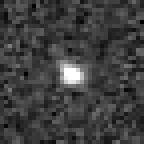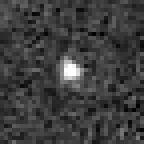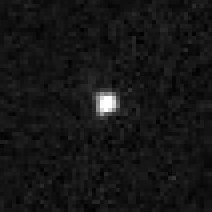5145 Pholus is an eccentric centaur in the outer Solar System, approximately 180 kilometers in diameter, that crosses the orbit of both Saturn and Neptune. It was discovered on 9 January 1992 by American astronomer David Rabinowitz (uncredited) of UA's Spacewatch survey at the Kitt Peak National Observatory in Arizona, United States. The very reddish object has an elongated shape and a rotation period of 9.98 hours. It was named after the centaur Pholus from Greek mythology.
51826 Kalpanachawla (provisional designation 2001 OB34) is an Eoan asteroid in the outer region of the asteroid belt, approximately 7 kilometers in diameter. It was discovered on 19 July 2001, by astronomers of the Near-Earth Asteroid Tracking program at Palomar Observatory in California, United States. The asteroid was named for Indo-American astronaut and mission specialist Kalpana Chawla, who died in the Space Shuttle Columbia disaster.
8405 Asbolus is a centaur orbiting in the outer Solar System between the orbits of Jupiter and Neptune. It was discovered on 5 April 1995, by James Scotti and Robert Jedicke of Spacewatch (credited) at Kitt Peak Observatory in Arizona, United States. It is named after Asbolus, a centaur in Greek mythology and measures approximately 80 kilometers in diameter.

15017 Cuppy, provisional designation 1998 SS25, is a Florian asteroid from the inner regions of the asteroid belt, approximately 2 kilometers in diameter. It was discovered on 22 September 1998, by the Lowell Observatory Near-Earth-Object Search (LONEOS) at its Anderson Mesa Station, Arizona, United States. The asteroid was named for American humorist Will Cuppy.
20461 Dioretsa is a centaur and damocloid on a retrograde, cometary-like orbit from the outer Solar System. It was discovered on 8 June 1999, by members of the LINEAR team at the Lincoln Laboratory Experimental Test Site near Socorro, New Mexico, United States. The highly eccentric unusual object measures approximately 14 kilometers in diameter. It was named Dioretsa, an anadrome of "asteroid".

7066 Nessus is a very red centaur on an eccentric orbit, located beyond Saturn in the outer Solar System. It was discovered on 26 April 1993, by astronomers of the Spacewatch program at the Kitt Peak National Observatory in Tucson, Arizona. The dark and reddish minor planet is likely elongated and measures approximately 60 kilometers in diameter. It was named after Nessus from Greek mythology.

10370 Hylonome (; prov. designation: 1995 DW2) is a minor planet orbiting in the outer Solar System. The dark and icy body belongs to the class of centaurs and measures approximately 72 kilometers (45 miles) in diameter. It was discovered on 27 February 1995, by English astronomer David C. Jewitt and Vietnamese American astronomer Jane Luu at the U.S. Mauna Kea Observatory in Hawaii, and later named after the mythological creature Hylonome.
51825 Davidbrown (provisional designation 2001 OQ33) is an Eoan asteroid in the outer region of the asteroid belt, approximately 5 kilometers in diameter. It was discovered on 19 July 2001, by astronomers of the Near-Earth Asteroid Tracking program at Palomar Observatory in California, United States. The asteroid was named for American astronaut David Brown, who died in the Space Shuttle Columbia disaster.
51823 Rickhusband (provisional designation 2001 OY28) is a dark Lixiaohua asteroid from the outer regions of the asteroid belt, approximately 9 kilometers in diameter.
52872 Okyrhoe is a centaur orbiting in the outer Solar System between Jupiter and Saturn. It was discovered on 19 September 1998, by the Spacewatch survey at Kitt Peak Observatory in Arizona, United States, and named after Ocyrhoe from Greek mythology.
(35671) 1998 SN165 (provisional designation 1998 SN165) is a trans-Neptunian object from the Kuiper belt located in the outermost region of the Solar System. It was discovered on 23 September 1998, by American astronomer Arianna Gleason at the Kitt Peak National Observatory near Tucson, Arizona. The cold classical Kuiper belt object is a dwarf planet candidate, as it measures approximately 400 kilometers (250 miles) in diameter. It has a grey-blue color (BB) and a rotation period of 8.8 hours. As of 2021, it has not been named.
83982 Crantor (provisional designation 2002 GO9) is a centaur in a 1:1 resonance with Uranus, approximately 60 kilometers (37 miles) in diameter. It was discovered on 12 April 2002, by astronomers of the Near-Earth Asteroid Tracking at the Palomar Observatory in California, United States. This minor planet was named for Crantor from Greek mythology.

31824 Elatus (; provisional designation 1999 UG5) is a very red centaur from the outer Solar System, approximately 48 kilometers (30 miles) in diameter. It was discovered on 29 October 1999, by astronomers of the Catalina Sky Survey at Mount Lemmon Observatory in Arizona, United States. The minor planet was named after Elatus, a centaur from Greek mythology.

32532 Thereus (; provisional designation 2001 PT13) is a centaur from the outer Solar System, approximately 80 kilometers (50 miles) in diameter. It was discovered on 9 August 2001, by astronomers of the Near-Earth Asteroid Tracking program at the Palomar Observatory in California, United States. This minor planet was named for the phrase thēreios bia 'beastly strength', used to describe centaurs in Greek mythology.

45300 Thewrewk (provisional designation 2000 AF45) is a dark background asteroid from the outer regions of the asteroid belt, approximately 13 kilometers in diameter. It was discovered on 1 January 2000, by astronomers Krisztián Sárneczky and László Kiss at the Piszkéstető Station of the Konkoly Observatory in Hungary. The asteroid was named after Hungarian astronomer Aurél Ponori Thewrewk.
11948 Justinehénin, provisional designation 1993 QQ4, is a Themistian asteroid from the outer region of the asteroid belt, approximately 12 kilometers in diameter.

(127546) 2002 XU93, provisional designation 2002 XU93, is a trans-Neptunian object and centaur on highly inclined and eccentric orbit in the outer region of the Solar System. It measures approximately 170 kilometers (110 mi) in diameter and is one of few objects with such an unusual orbit. It was discovered on 4 December 2002, by American astronomer Marc Buie at the Kitt Peak National Observatory in Arizona, United States.
(523759) 2014 WK509 (provisional designation 2014 WK509) is a trans-Neptunian object in the scattered disc, located in the outermost regions of the Solar System. It was discovered on 14 September 2010, by Pan-STARRS at Haleakala Observatory on the island of Maui, Hawaii, in the United States. The object's diameter has been estimated to measure approximately 600 kilometers.
(523727) 2014 NW65 (provisional designation 2014 NW65) is a large centaur from the outer Solar System, approximately 220 kilometers (140 miles) in diameter. It was discovered on 14 July 2010 by astronomers with the Pan-STARRS-1 survey at Haleakala Observatory, Hawaii, in the United States. The minor planet was numbered in 2018 and has not been named.
(495603) 2015 AM281 (provisional designation 2015 AM281) is a resonant trans-Neptunian object in the outermost region of the Solar System, guesstimated at approximately 470 kilometers (290 miles) in diameter. It was discovered on 13 March 2010, by astronomers with the Pan-STARRS survey at Haleakala Observatory, Hawaii, United States.








